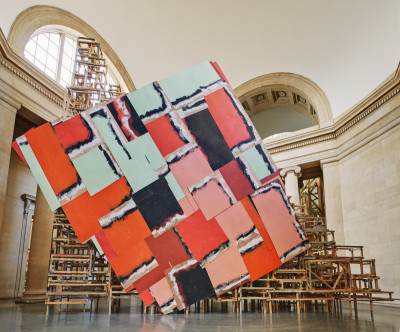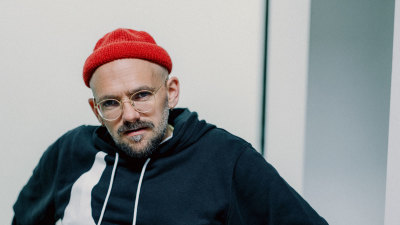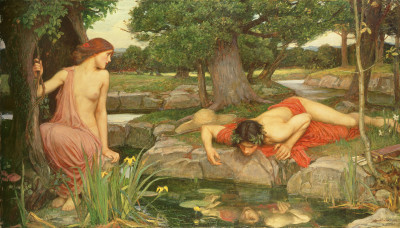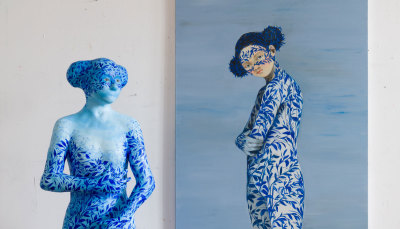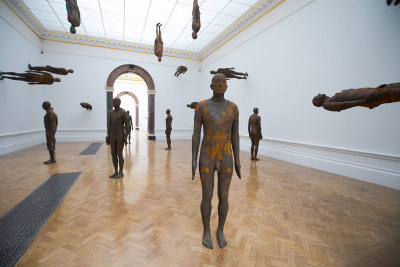10 minutes with… Phyllida Barlow RA
10 minutes with… Phyllida Barlow RA
By Harriet Baker
Published 12 November 2015
As she turns her focus to a group of small sculptures, Phyllida Barlow tells us what music inspires her and why she loves Picasso.
-
Phyllida Barlow’s sculptures are experiments with colour and collage, making use of everyday materials such as cardboard, fabric, timber, polystyrene, plaster, scrim and cement. Her installations – her largest and most ambitious project to date took over Tate Britain’s Duveen Galleries in 2014 – redefine the spaces they inhabit. Despite their abstract and industrial qualities, her works retain elements of spontaneity and sensitivity.
Barlow has been an influential teacher in London. At the Slade School of Fine Art, her students have included Turner Prize-winning and nominated artists Rachel Whiteread and Angela de la Cruz. In 2006, she was invited to create Untitled Red/Brown for the Royal Academy courtyard and was elected a Royal Academician in 2011.
We caught up with the sculptor as she prepares a group of smaller works from the offcuts of her studio.
What are you working on at the moment?
Currently I’m working on a group of small sculptures, which is a bit more unusual for me. At the Fruitmarket Gallery in Edinburgh where I exhibited this summer, I had made 20 small works to accompany the main installation. These smaller works have been the inspiration for what I’m working on just now.
They’re assemblages on a very small scale and they’re made from the debris and the offcuts that I collect in my studio. I’ve been making them very quickly, using basic methods of pulling the materials together, through tying and using plaster and cement. When I’m constructing them, I’m playing with polystyrene, timber, plywood and fabric; it’s as though I’m doodling. There’s something mindless about making them, but I’m also developing a way of thinking and seeing through the materials themselves.
I’m also repairing a work called Upturned House which is going to Tate Modern in January. It needs to be taken apart and put together again. It’s difficult because normally I construct the piece intuitively. Re-assembling something to put it up somewhere else is challenging because I want to retain that element of spontaneity.
What’s your earliest memory of art?
I have two early memories of art. My grandfather collected Chinese ceramics. There were painted fired clay camels and buffalo and they always fascinated me. I especially loved a jade buffalo; it was a fabulous object and I can remember the shape of it filling my whole hand. I can also remember looking at my parent’s art books, particularly those on Van Gogh.
Drawing is what I can remember doing, and making small objects out of very basic materials, which my mother taught me how to do. I decided I wanted to make sculpture early on at art school when I was 16. One of my tutors said, “I think you paint in a sculptural way. Why not transfer what you do in painting into clay?” And it was an awakening.
-

Phyllida Barlow RA
Photo: Thierry Bal
-
Which work of art do you wish you’d created?
Maybe Picasso’s Glass of Absynthe, because it does everything. It’s formally complicated with convex and concave shapes, but it’s also very deceitful because it has shadows painted on it as well as having real shadows. I like the way it uses a readymade, the silver absinthe spoon, balanced on top of it. It’s a small object that is a premonition of what the twentieth is going to do; a psychic object in that sense, because it heralds so much of what sculpture would become involved in.
I like the collage-like aspect of Picasso’s sculptures, which are different from his plaster and clay sculptures. They are small and simple assemblages made from the remnants of works in his studio – corrugated paper and card and all sorts of materials.
How do you know when a piece of work is finished?
I’m never entirely sure whether something is finished or not, but I do stop eventually. It is a real issue with the way that I work. When I’m using plaster and cement, which requires very quick and simple gestures, it’s easy to think that there can be another layer and then another layer. But it can become overcooked and then it all has to be stripped back and then I have to begin again. When I’m using those materials, it’s as though I’ve never made anything before. They cast a spell in terms of wanting to take charge, which means I build up quite a relationship with them. Not knowing when to finish something is all part of that energy. But then time, energy and interest run out. More often than not, those are factors which determine the conclusion of that particular work.
Each work takes a different amount of time to complete. Yesterday, I made four of the small sculptures. Meanwhile, in the corner of the studio, there’s a sculpture that I’ve been working on for nearly three years. I recently made some sculptures for the Nasher Centre (pictured) which took nearly 18 weeks to complete, and I found that quite difficult. I haven’t got a huge threshold of patience for things hanging around for ages.
-

Phyllida Barlow RA, Set, installation view, 27 June – 18 October 2015.

Phyllida Barlow RA, Tryst, installation view, 30 May – 30 August 2015.
-
Where were you when you found out you had been elected an Academician?
I was in my studio when Alison Wilding RA called. I was very surprised and excited, and perhaps I was scared about the role, too. I remember I couldn’t initially commit to it because I wasn’t quite sure what exactly it was. Being an Academician requires quite a commitment, and I don’t think I’ve been able to fulfil that yet because it’s been such a busy time at the studio over the last four years.
If you were President of the RA for the day, what would you do?
Aspects of contemporary art can be challenging. I would enjoy discussing what might perplex an audience about the complicated aspects of contemporary art. Such a discussion could include how art defies logic and being categorised, and how it might not have beauty as its first objective.
What would be your advice to aspiring artists?
Try and balance how you make work with getting some kind of income. And don’t expect it all to happen at once; go for the long game. Most of all, be patient with yourself and just keep going.
What music do you listen to while you’re working?
My studio assistants are always listening to music, and always arguing about what they want to listen to. When it’s just me in the studio, or when I’m working at home (where I have a small studio for drawing and smaller works), I listen to a broad range of Classical music, including very contemporary music, as well as Schubert, Beethoven, Bartók, Webern, Shostakovich, Janácek and Messiaen.
-

Phyllida Barlow RA, Tryst, installation view, 30 May – 30 August 2015.

Phyllida Barlow RA, Dock, installation view, 31 March – 19 October 2014.




